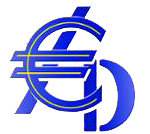Europe and the Euro today 1. Financial institutions and the Euro The Euro was one of the major stakes of European construction. Its success was conditioned by a clear distribution of the tasks between the various institutional actors. - On the issuing volume: the ECB determines the quantity of the national issues. Each country is seen granting a maximum quota of striking for each coin at the beginning of the considered issuing year. - On the common side of each coin: the ECB fixes the specifications to be followed and communicates to the countries the modifications having to be brought to this side. It was thus for the news sides of the coins of 10, 20, 50 cent, €1 and €2. Each country was to carry out the modifications before December 31, 2008. - On the striking quality: the ECB was seen allotting a role of audit in order to guarantee a high and equivalent level of all circulation coins. The roles' allocation between the institutional actors was clearly established. This precise framework makes it possible to consider progressive integrations of new Member States in the Euro area. 2. Potential members of the EU The (potential) candidates are still numerous: - Croatia seems to be on the way to become the 28th member (2010?) 3. The Euro area and dependences Strictly speaking, the Euro area consists in the 15 countries which are Member States (MS) of the EU and which introduced the Euro as a currency. To the 12 initial ones of the 1st of January 2002, Slovenia was added in 2007, Cyprus and Malta in 2008. These 15 MS are the only ones to take part in the functioning of the European Central Bank (ECB) of Frankfurt, which supremely defines the monetary policy of the area. On January 1, 2009, Slovakia will be the 16th participant of the Euro zone. For the next ones (the Baltic States particularly), it will undoubtedly be necessary to wait… several years (the needed time for the convergence criteria to be matched) but the restarting of inflation and the recession which is foreseen risk to compromise the efforts of these countries which succeeded in passing from a collectivist and planned economy to a real market economy in less than 20 years. Potentially, to date, the Euro area is full of 25 of the 27 MS because, except Great Britain (which did not take part in the monetary part of Maastricht) and Denmark (which profits from an exemption), all were committed by treaty adopting the Euro as single currency. Sweden also had adopted it but the country not being qualified in 1999, its government organized thereafter a referendum, breaking, at least on the legal level, with its international obligations. It had indeed ratified the Treaty of Maastricht. Other sovereign states, non-member of the EU, can adopt the Euro like single currency Already, on the 1st of January 2002, Monaco, San Marino, the Vatican and Andorra had introduced the new currency. But it was for historical and practical reasons. The three first ones had even been able to preserve their existing specificity for the national side and the issuing possibilities of commemorative coins. Andorra, which did not have this specific tradition, passed to the Euro without particular variation, but could extremely well obtain it in the future. UNO, managing Kosovo, chose in 1999 to assign the Deutsch Mark like currency (soon replaced by the Euro) . The first act of independence of Montenegro was to adopt “unilaterally” this currency. This however does not confer to this country any specific right. In the EU itself, the case of Bulgaria is interesting: Lev has a fixed parity with the euro, but the ECB refused the integration in the European Exchange Rate Mechanism (ERM II), which in fact would qualify Bulgaria. Contrary, Denmark, which profits from the exemption “opt out”, evolves since the origin of ERM II in this system. The day when the Danes will vote the end of the exemptions (in several fields, including the currency), they will be qualified at once and will be able to introduce the Euro as soon as possible. At the present time besides, the Danish government thinks to a possible adhesion at the Euro area. Moreover, the currency of Franc CFA area of West Africa (8 countries), that of Central Africa (6 countries), in addition the Comorian Franc, all have a fixed parity with the Euro. Other countries examine attentively an adhesion to the Euro, by a way or another. For example Iceland, where the business circles would like an unilateral adhesion. This country turned much away from the USA, but is not ready for an adhesion, particularly because of the fishing quotas. |
 AD€ - Les Amis de l'Euro
AD€ - Les Amis de l'Euro